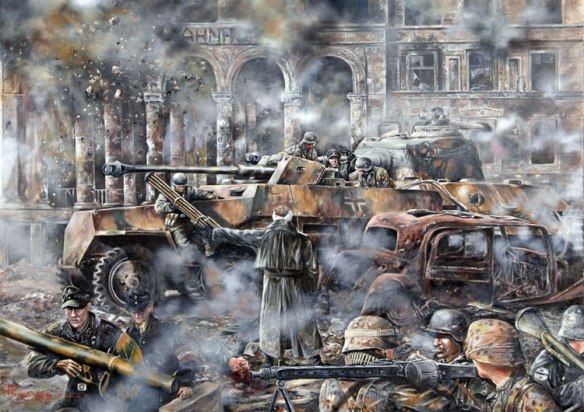The Charlotten Bridge over the Havel River in Spandau used for the German breakout to the west. The suburb of Stresow on the right is dominated by the massive Deutsche-Industrie-Werke factory producing guns and tanks.
Marshal Zhukov, on hearing of the breakout attempts from General Kuznetsov of the 3rd Shock Army, ordered a maximum alert. He was understandably perturbed by the `unpleasant suggestion’ that senior Nazis, especially Hitler, Goebbels and Bormann, might be trying to escape. It was not hard to imagine Stalin’s anger if this should happen. Soviet officers hastily rounded up men who were celebrating May Day with alcohol and women-hunts. Brigades from the 2nd Guards Tank Army were sent in pursuit and cordons hurriedly put into place. This thwarted a second attempt to break through northwards up the Schonhauserallee by Major General Barenfanger’s troops from the eastern side of the Zitadelle defence area. Barenfanger, a devoted Nazi, committed suicide with his young wife in a side street.
Shortly before midnight, the time when Colonel Haller had promised to surrender the Zoo flak tower, the remaining tanks and half-tracks of the Muncheberg Panzer Division and the 18th Panzergrenadier Division set out from the Tiergarten westwards. They then pushed north-westwards towards the Olympic stadium and Spandau. Word had also spread rapidly in this case. The rumour was that Wenck’s army was at Nauen, to the north-west of the city, and hospital trains were waiting there to take soldiers to Hamburg. Thousands of stragglers and civilians made their way on foot and in a variety of vehicles in the same direction. One group of around fifty came in three trucks from the Grossdeutscher Rundfunk. They included Himmler’s very different younger brother, Ernst, a leading studio technician.
The Charlottenbrucke, the bridge over the Havel to the old town of Spandau, was still standing and held by Hitler Youth detachments. In heavy rain and under artillery fire from the 47th Army, the armoured vehicles charged across, followed by a ragged crowd of soldiers and civilians. The slaughter was appalling. `There was blood everywhere and trucks were exploding,’ one of the escapers recounted. A tactic was instinctively worked out. Self-propelled army flak vehicles with quadruple 20mm guns gave covering fire from the eastern bank to keep Soviet heads down, and during this frantic firing for up to a minute, another wave of civilians and soldiers surged across to hide in the ruined houses opposite. The slow and the lame were caught in the open by Soviet guns. As well as wave after wave of people on foot, trucks, cars and motorcycles also crossed, running over bodies already crushed by the tracks of armoured vehicles. Ernst Himmler was one of the many who died on the Charlottenbrucke, either shot or trampled in the desperate rush.
Although the massacre at the bridge was horrific, the sheer weight of German numbers forced the Soviet troops back from the river bank. But Soviet machine guns in the tower of the Spandau town hall continued to cause heavy losses. Two of the Tiger tanks then shelled the Rathaus itself, and a small group from the 9th Parachute Division stormed the tower. The main force of armoured vehicles pushed on westwards towards Staaken, but most of the troops were encircled or rounded up over the next two days. Only a handful reached the Elbe and safety. Soviet officers searched the burnt-out remains of tanks carefully on orders from Front headquarters. `Among the crews killed,’ wrote Zhukov, ‘none of Hitler’s entourage were found, but it was impossible to recognize what was left in the burnt-out tanks.’ Nobody knows how many died in these attempts to escape Soviet captivity.
